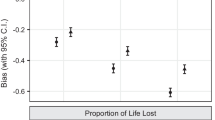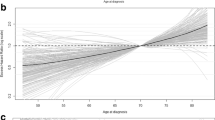Abstract
The mortality impact in cancer screening trials and population programs is usually expressed as a single hazard ratio or percentage reduction. This measure ignores the number/spacing of rounds of screening, and the location in follow-up time of the averted deaths vis-a-vis the first and last screens. If screening works as intended, hazard ratios are a strong function of the two Lexis time-dimensions. We show how the number and timing of the rounds of screening can be included in a model that specifies what each round of screening accomplishes. We show how this model can be used to disaggregate the observed reductions (i.e., make them time-and screening-history specific), and to project the impact of other regimens. We use data on breast cancer screening to illustrate this model, which we had already described in technical terms in a statistical journal. Using the numbers of invitations different cohorts received, we fitted the model to the age- and follow-up-year-specific numbers of breast cancer deaths in Funen, Denmark. From November 1993 onwards, women aged 50–69 in Funen were invited to mammography screening every two years, while those in comparison regions were not. Under the proportional hazards model, the overall fitted hazard ratio was 0.82 (average reduction 18%). Using a (non-proportional-hazards) model that included the timing information, the fitted reductions ranged from 0 to 30%, being largest in those Lexis cells that had received the greatest number of invitations and where sufficient time had elapsed for the impacts to manifest. The reductions produced by cancer screening have been underestimated by inattention to their timing. By including the determinants of the hazard ratios in a regression-type model, the proposed approach provides a way to disaggregate the mortality reductions and project the reductions produced by other regimes/durations.




Similar content being viewed by others
References
Thompson SG, Ashton HA, Gao L, Scott RA, On behalf of the Multicentre Aneurysm Screening Study Group. Screening men for abdominal aortic aneurysm: 10 year mortality and cost effectiveness results from the randomised Multicentre Aneurysm Screening Study. BMJ. 2009;338:b2307. https://doi.org/10.1136/bmj.b2307.
Schröder FH, Hugosson J, Roobol MJ, et al. Screening and prostate-cancer mortality in a randomized European study. N Engl J Med. 2009;360:1320–8.
Hanley JA. Mortality reductions produced by sustained prostate cancer screening have been underestimated. J Med Screen. 2010;17(3):147–51. https://doi.org/10.1258/jms.2010.010005.
Law M. What now on screening for prostate cancer?. J Med Screen. 2009;16:109–11.
Djulbegovic M, Beyth RJ, Neuberger MM, Stoffs TL, Vieweg J, Djulbegovic B, Dahm P. Screening for prostate cancer: systematic review and meta- analysis of randomised controlled trials. BMJ. 2010;341:c4543. https://doi.org/10.1136/bmj.c4543.
Hanley JA. Measuring mortality reductions in cancer screening trials. Theme issue on screening. Epidemiol Rev. 2011;33:36–45. https://doi.org/10.1093/epirev/mxq021 Epub 2011 May 30.
Jacobs IJ, Menon U, et al. Ovarian cancer screening and mortality in the UK collaborative trial of ovarian cancer screening (UKCTOCS): a randomised controlled trial. www.thelancet.com. Published Online 17 Dec 2015. http://dx.doi.org/10.1016/S0140-6736(15)01224-6.
Shaukat A, Mongin SJ, Geisser MS, Lederle FA, Bond JH, Mandel JS, Church TR. Long-term mortality after screening for colorectal cancer. New Engl J Med. 2013;369:1106–14.
Liu Z, Hanley JA, Saarela O, Dendukuri N. A conditional approach to measure mortality reductions due to cancer screening. Int Stat Rev. 2015;. https://doi.org/10.1111/insr.12088.
Hanley JA. Analysis of mortality data from cancer screening studies: looking in the right window. Epidemiology. 2005;16(6):786–90.
Welch HG, Robertson DJ. Colorectal cancer on the decline—Why screening can’t explain it all. N Engl J Med 2016;374:1605–7. https://doi.org/10.1056/NEJMp1600448A. 28 April 2016, see also: Kolata G, Medical mystery of the best kind: major diseases are in decline. New York Times, 8 July 2016.
Marcus PM, Bergstralh EJ, Fagerstrom RM, et al. Lung cancer mortality in the Mayo Lung project: impact of extended follow-up. J Natl Cancer Inst. 2000;92:1308–16.
Baker S, Kramer BS, Prorok PC. Early reporting for cancer screening trials. J Med Screen. 2008;15:122–9.
Tabár L, Vitak B, Chen TH, Yen AM, Cohen A, Tot T, Chiu SY, Chen SL, Fann JC, Rosell J, Fohlin H, Smith RA, Duffy SW. Swedish two-county trial: impact of mammographic screening on breast cancer mortality during 3 decades. Radiology. 2011;260:658–63.
Hanley JA. Analysis of mortality data from cancer screening studies: looking in the right window. Epidemiology. 2005;16(6):786–90.
Miettinen OS, Karp I. Epidemiological research: an introduction. Dordrecht: Springer; 2012.
Caro J, McGregor M. Screening for breast cancer in women aged 40–49 years. Montreal, Quebec, Canada: Agence d’évaluation des technologies et des modes d’intervention en santé [AETMIS, the Québec government agency responsible for health services and technology assessment]; 1993:91. (CETS report no. 22). http://www.aetmis.gouv.qc.ca/site/download.php?f1/4503b634ef04a597215ff3dc734d8d84e. Accessed 6 July 2005.
Miettinen OS, Henschke CI, Pasmantier MW, et al. Mammographic screening: no reliable supporting evidence? Lancet. 2002;359(9304):404–5. A fuller account can be found at http://image.thelancet.com/extras/1093web.pdf. Accessed 6 July 2005.
Liu Z. Measuring the mortality reductions due to cancer screening. Ph.D. Dissertation. McGill University Libraries. 2015. http://digitool.library.mcgill.ca/R/?func=dbin-jump-full&object_id=130321.
Olsen AH, Njor SH, Vejborg I, Schwartz W, Dalgaard P, Jensen M-J, Tange UB, Blichert-Toft M, Rank F, Mouridsen H, Lynge E. Breast cancer mortality in Copenhagen after introduction of mammography screening: cohort study. BMJ. https://doi.org/10.1136/bmj.38313.639236.82. Published 13 Jan 2005.
Njor SH, Schwartz W, Blichert-Toft M, Lynge E. Decline in breast cancer mortality: How much is attributable to screening? J Med Screen. 2015;22(1):20–7. https://doi.org/10.1177/0969141314563632msc.sagepub.com.
Hanley JA. Analysis of mortality data from cancer screening studies: looking in the right window. Epidemiology. 2005;16(6):786–90.
Liu Z, Hanley JA, Strumpf EC. Projecting the yearly mortality reductions due to a cancer screening program. J Med Screen. 2013;20:156–64. https://doi.org/10.1177/0969141313504088.
Clayton D, Hills M. Statistical models in epidemiology. New York: Oxford University Press; 1993.
Morrison AS. Screening in chronic disease. New York: Oxford University Press; 1985.
Hanley JA, Liu Z, Saarela O. Fitting a model of the mortality reductions produced by one/several rounds of cancer screening: time and sample size considerations. Presentation (and abstract). In: 2016 Meeting of the Statistical Society of Canada, Brock University, Ontario, Canada.
Acknowledgements
The work was supported by a grant “Measuring the mortality reductions produced by cancer screening” to James Hanley from the Canadian Institutes of Health Research (CIHR). CIHR had no role in the study design; in the collection, analysis, and interpretation of data; in the writing of the report; and in the decision to submit the article for publication; i.e., these activities were carried out by the authors, independently of the funder. Both authors had access to the Lexis-cell-level data used in the study and take responsibility for the integrity of the data and the accuracy of the data analysis.
Author information
Authors and Affiliations
Contributions
Authors’ contribution
James Hanley suggested the re-analysis; the authors jointly presented preliminary results, based on data to 2009, at the International Biometric Conference in Victoria, British Columbia, Canada in July 2016. Both drafted the manuscript, and both are guarantors for the study.
Corresponding author
Ethics declarations
Conflicts of interests
Both authors declare: no support from any organisation for the submitted work; no financial relationships with any organisations that might have an interest in the submitted work in the previous three years; no other relationships or activities that could appear to have influenced the submitted work.
Ethical approval
The study was approved by Region Midt under their umbrella permission form the Danish Data Inspection Board. According to Danish legislation this serves as ethical approval of register-based research projects (journal number 1-16-02-90-17).
Rights and permissions
About this article
Cite this article
Hanley, J.A., Njor, S.H. Disaggregating the mortality reductions due to cancer screening: model-based estimates from population-based data. Eur J Epidemiol 33, 465–472 (2018). https://doi.org/10.1007/s10654-017-0339-7
Received:
Accepted:
Published:
Issue Date:
DOI: https://doi.org/10.1007/s10654-017-0339-7




